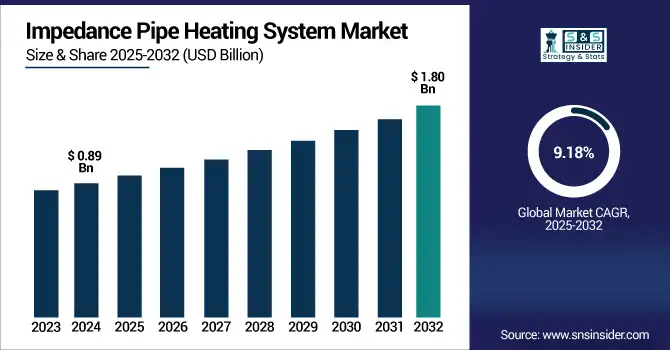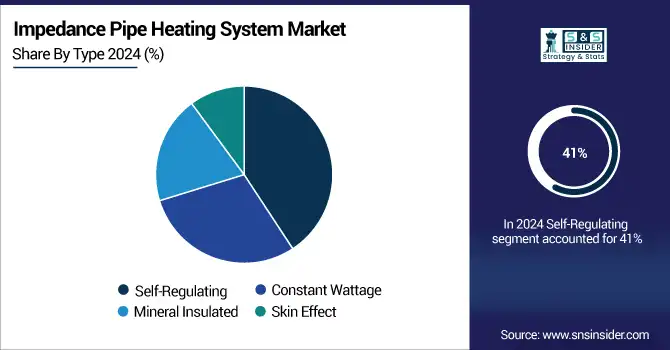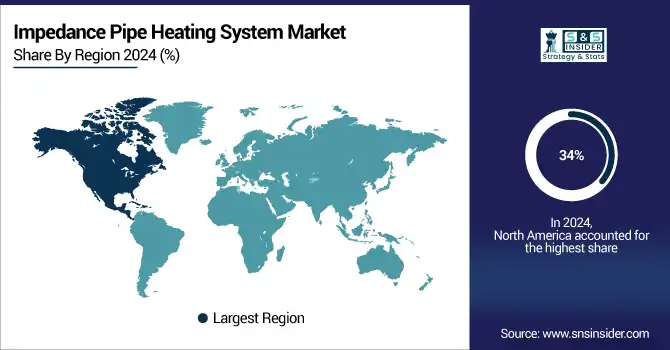Impedance Pipe Heating System Market Report Scope & Overview:
The Impedance Pipe Heating System Market Size was valued at USD 0.89 Billion in 2024 and is expected to reach USD 1.80 Billion by 2032 and grow at a CAGR of 9.18%over the forecast period 2025-2032.

To Get more information on Impedance Pipe Heating System Market - Request Free Sample Report
The Impedance Pipe Heating System market is attracting more and more attention due to growing demand for power effective and reliable freeze protection and process heating. These systems involve the application of electric current through the wall of the pipe, and provide even heat distribution, rapid warm-up, and efficient energy transfer. They are ideal for long lengths of pipe, for hazardous areas because are running on low voltage, are intrinsically safe, and are very energy-efficient. There is no need for external heaters, making maintenance and installation less burdensome. Rising application in various sectors such as oil & gas, chemical processing, and wastewater treatment, particularly in extreme climatic conditions, is augmenting the adoption. Further, the growing importance of both energy efficiency and system dependability is consistent with the increasing application of impedance heating in modern industrial plants.
In June 2025, First gas flows through Strohm’s TCP system at Germany’s Wilhelmshaven 2 terminal, part of a collaborative project with TES and ECOnnect. The pipeline supports LNG transfer and is designed for future CO₂ use, marking a milestone in Europe’s energy infrastructure.
The U.S Impedance Pipe Heating System Market Size was valued at USD 0.20 Billion in 2024 and is expected to reach USD 0.33 Billion by 2032 and grow at a CAGR of 6.43% over the forecast period 2025-2032, on account of increasing demand for energy-efficient and maintenance-free heating solutions in sectors including oil & gas, chemicals, and power generation. Rising infrastructure replacement rates, extreme winter temperatures, and demand for effective freeze protection have all contributed to the increased prevalence of impedance heating systems on industrial pipeline.
Impedance Pipe Heating System Market Dynamics:
Drivers:
-
Rising Adoption of Energy Raft Foundations in Urban Geothermal Applications
The growing use of energy raft foundations in dense urban environments is emerging as a key driver for the geothermal heating and cooling market. With the rising energy requirement and exacerbating urban heat island (UHI) effect in cities such as Taipei, integrated structural-thermal exchange solutions are drawing growing interest. Energy raft foundations (E-RF), comprising building foundations that also act as ground heat exchanger (GHE) pipes, have the advantage of combining two functions: support and passive environmental conditioning. Advanced numerical tools as 3-dimentional coupled thermo-hydraulic models demonstrate the performance of these systems to lower the cooling demand as well as the thermal impact to the vicinity. This advancement can contribute to sustainable urban development, and is in line with global Impedance Pipe Heating Systems trends of decarbonizing buildings and decreasing the dependence on conventional HVAC systems.
Taipei uses energy raft foundation with geothermal pipes for effective heating and cooling of its building (2025). 3D thermo-hydraulic modelling verifies diminished AC load and lower UHI effect for high-density zones.
Restraints:
-
Limited Cost Efficiency for Short Pipelines Reduces Impedance Heating Adoption
Impedance pipe heating systems are engineered to deliver maximum efficiency over long-distance pipeline runs. However, in short pipeline applications, the high initial setup cost and engineering complexity outweigh the energy savings and operational benefits. This results in a less favorable cost-to-benefit ratio when compared to simpler solutions like self-regulating or resistance cable systems. As a result, industries with shorter pipeline needs often opt for alternative heating methods that are quicker to install, easier to maintain, and more economical. This limitation restricts the widespread use of impedance systems in small-scale or modular facilities, thereby slowing market penetration in diverse industrial segments where short pipelines are common.
Opportunities:
-
Rising Demand for Smart Energy Controls Creates Growth Opportunity for Impedance Pipe Heating Systems
The growing emphasis on reducing industrial energy consumption and carbon emissions is creating strong market opportunities for impedance pipe heating systems. Sectors are progressively moving towards new high-efficiency heating processes offering an accurate temperature profile control, minimizing heat losses, and optimizing energy consumption. Impedance heating, an efficient technology compatible with smart control and monitoring, is well suited to meet this demand. Their on-demand functionality and low upkeep requirements make them perfect for eco-thoughtful operations. Increasing demand for digital integration and energy savings will further augment the market for intelligent Impedance Pipe Heating Systems trends in different end use industries.
RAYCHEM introduces PASC-enabled Smart Heat Tracing Controls to cut energy use by up to 70% (Nov 18, 2024).The new system optimizes electric heat tracing efficiency, reducing unnecessary power consumption in industrial freeze protection applications.
Challenges:
-
High Design Complexity Restricts Widespread Adoption of Impedance Pipe Heating Systems
A major challenge in the impedance pipe heating system market stems from the need for highly customized engineering tailored to each specific application. These systems operate by having an electrical current pass directly through the pipe (the properties of the pipe material, the length of the pipe, the diameter, insulation, etc., must be calculated depending on... Such complexity lengthens design cycles, adds costs to projects and increases the need for specialized technical skills. This, in turn, has resulted in the technology not being widely implemented especially with many industries which have small scale and intermittent pipeline systems. This does not allow to easily scale impedance heating solutions onto the larger market, although being highly operative energy-wise.
Impedance Pipe Heating System Market Segmentation Analysis:
By Type
Self-Regulating is holding the largest segment in Impedance Pipe Heating System Market share of around 41% in 2024, due to their inherent energy efficiency, safety, and adaptive performance. These systems automatically adjust their heat output in response to ambient temperature changes, minimizing energy waste and enhancing operational reliability. Their ease of installation, reduced maintenance needs, and ability to prevent overheating make them highly suitable for freeze protection and temperature maintenance across diverse industrial and commercial applications. Growing demand for low-maintenance, efficient heating solutions continues to drive their market dominance.

By Application
The Oil & Gas segment held a dominant Impedance Pipe Heating System Market share of around 45% in 2024, as it require reliable freeze protection and flow assurance in long pipe lines, especially the ones located in cold regions. Impedance heating provides even heat distribution, reduced maintenance, and hazardous location compatibility, and is therefore a good fit for upstream, midstream, and downstream applications where reliable operation and safety are top priority.
The Chemical segment is expected to experience the fastest growth in the Impedance Pipe Heating System Market over 2025-2032 with a CAGR of 11.04%, due to rise in demand for temperature regulation in critical chemical procedures. The conductive heater provides even heating and no hot spots, which can cause temperature-sensitive or potentially hazardous chemicals to decompose. This has additional benefits in energy efficiency and safety that drive its use throughout today’s chemical processing plants.
By End User
The Industrial segment held a dominant Impedance Pipe Heating System Market share of around 65% in 2024, on account of its applications across oil & gas, chemicals, and power generation. They have a need of an always on and efficient heating process for lengthy pipes in tough conditions. Impedance-based systems inherently have durability, low-maintenance, and can be used in hazardous areas; and due to these attractive features, they are suitable for industrial purposes.
The Commercial segment is expected to experience the fastest growth in the Impedance Pipe Heating System Market over 2025-2032 with a CAGR of 10.55%, on account of increasing requirement for low energy heating solutions in commercial sites, such as hospitals, commercial building and retail infrastructure. Its low maintenance, ease of use, and safety in preventing pipes freezing in severe winter weather, also qualify it for commercial use. Also, rising emphasis on sustainable building technologies aids in its growing implementation.
Impedance Pipe Heating System Market Regional Outlook:
In 2024, North America led the Impedance Pipe Heating System market with a 34% share, owing to high oil & gas infrastructure, temperature drop and a growing demand for expeditious freeze protection. Impedance systems are more and more utilized in energy saving, safety to explosion of dangerous places and less maintenance, which are perfectly applicable for long big pipelines.
The Impedance Pipe Heating System market in the U.S. is expanding rapidly, due to increasing investments in energy infrastructure, harsh winter conditions, and growing demand for efficient, low-maintenance heating solutions across industrial sectors.
Asia Pacific is expected to witness the fastest growth in the Impedance Pipe Heating System market over 2025-2032, with a projected CAGR of 11.32%, on account of rapid industrialization, expanding oil & gas and chemical sectors and infrastructure development in China and India. Growing climate variability and an increased emphasis on energy efficiency and safety are promoting the uptake of new pipeline heating systems in industrial and commercial segments of the industry.
In 2024, Europe emerged as a promising region in the Impedance Pipe Heating System market, driven by stringent energy efficiency regulations, growing investments in renewable energy infrastructure, and the need for reliable pipeline heating in colder climates. Industrial modernization, especially in Germany and the Nordics, along with rising demand for low-emission heating technologies, is accelerating regional adoption of impedance heating systems.
Latin America and the Middle East & Africa (MEA) are experiencing steady growth in the Impedance Pipe Heating System market, has a growing demand due to energy efficient pipe heating solutions. Stringent environment conditions and the demand for assured flow in remote location are some of the additional factors supporting its adoption in various industries in these regions.

Get Customized Report as per Your Business Requirement - Enquiry Now
Key Players in the Impedance Pipe Heating System Market are:
Thermon Group Holdings, Inc., Eltherm GmbH, Vent Electric plc (Raychem), Chromalox, Inc., Danfoss A/S, Watlow Electric Manufacturing Company, BriskHeat Corporation, Bartec Top Holding GmbH, Parker Hannifin Corporation, Emerson Electric Co. and Others
Recent Developments:
-
In Nov 2024, Thermon launches high-voltage HTSX™ heat tracing system with 400 & 480 Vac options, extending circuit lengths by up to 110%. The advanced self-regulating solution improves safety, reliability, and installation efficiency for critical industrial heating applications.
-
In October 2024: Eltherm showcases new ELSR-H+ and ELSR-SH+ self-regulating cables and Smart Limiter at MEORGA 2024 in Bochum. The innovations offer advanced temperature control and enhanced safety for ATEX-compliant heat tracing applications across industries.
| Report Attributes | Details |
|---|---|
| Market Size in 2024 | USD 0.89 Billion |
| Market Size by 2032 | USD 1.80 Billion |
| CAGR | CAGR of 9.18% From 2024 to 2032 |
| Base Year | 2024 |
| Forecast Period | 2025-2032 |
| Historical Data | 2021-2023 |
| Report Scope & Coverage | Market Size, Segments Analysis, Competitive Landscape, Regional Analysis, DROC & SWOT Analysis, Forecast Outlook |
| Key Segments | • By Type (Self-Regulating, Constant Wattage, Mineral Insulated, Skin Effect) • By Application (Oil & Gas, Chemical, Food & Beverage, Water Treatment, Others) • By End-User (Industrial, Commercial, Residential) |
| Regional Analysis/Coverage | North America (US, Canada, Mexico), Europe (Germany, France, UK, Italy, Spain, Poland, Turkey, Rest of Europe), Asia Pacific (China, India, Japan, South Korea, Singapore, Australia, Taiwan, Rest of Asia Pacific), Middle East & Africa (UAE, Saudi Arabia, Qatar, South Africa, Rest of Middle East & Africa), Latin America (Brazil, Argentina, Rest of Latin America) |
| Company Profiles | The Impedance Pipe Heating System market companies are Thermon Group Holdings, Inc., Eltherm GmbH, nVent Electric plc (Raychem), Chromalox, Inc., Danfoss A/S, Watlow Electric Manufacturing Company, BriskHeat Corporation, Bartec Top Holding GmbH, Parker Hannifin Corporation, Emerson Electric Co. and Others |

